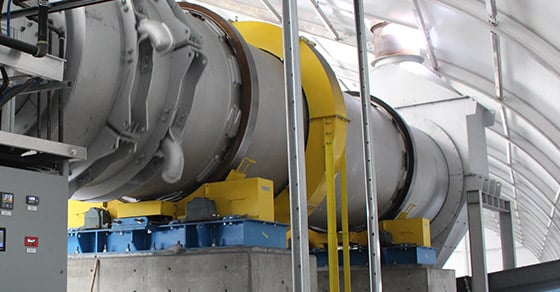Rotary drums, whether serving as a dryer, cooler, kiln, or otherwise, are essential process components in many industrial processes. In addition to being operationally critical, they also represent a significant capital investment. As such, prolonging rotary drum life through preventive maintenance is a key priority for plant managers.
What some plant managers may not realize, however, is that an effective preventive rotary drum maintenance program starts before the drum is even set into place, with the installation of the drum’s base.
About Rotary Drum Bases
Rotary drum bases differ depending on the size of the drum they will support. Larger drums rely on a three-base setup consisting of two trunnion bases and one base for drive components.
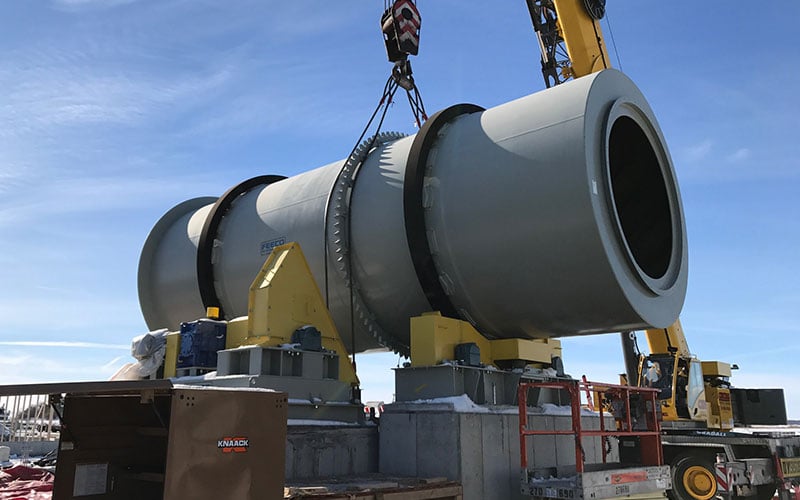
Separate drive and trunnion bases can be seen during the installation of this granulator
For smaller drums, FEECO utilizes our unitized drive base design to simplify drive assembly installation and maintenance. This design combines all drive assembly components and trunnions into a single base piece.

A unitized base, which combines trunnions and drive components, can be seen on this coating drum
No matter which setup is employed, proper base installation is essential to promoting a long service life and minimizing future maintenance requirements.
Consequences of a Poorly Installed Rotary Drum Base
As the foundation for the unit, poorly installed drum bases can lead to a number of problems, all of which have the potential to decrease service life, add to maintenance and labor costs, and increase downtime. The most common issues are summarized here.
Poor Trunnion Alignment
A poorly installed base can cause misalignment of the trunnion wheels, which in turn can put added stress on other mechanical components, as well as the drum itself. This ultimately exacerbates wear and increases maintenance requirements. Most often, this mechanical instability is visible as wear on tires and/or trunnions, as shown below.
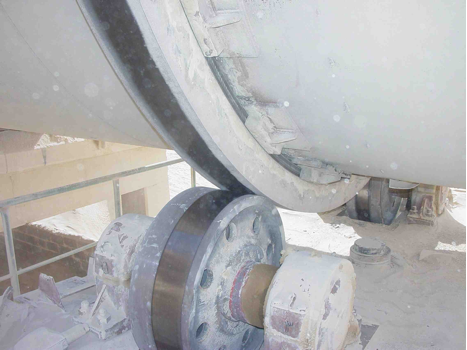
Improper alignment of the trunnion rollers is causing uneven wear to both tires and trunnions due to incomplete contact between the two.
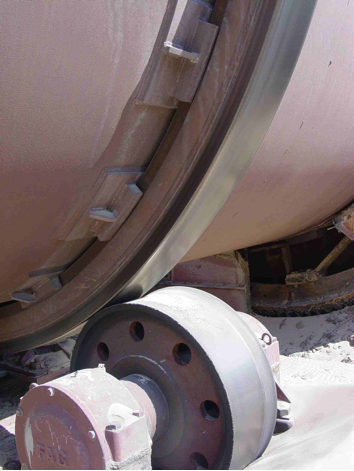
While the roller is making full contact with the tire, the roller is showing excessive wear, as can be seen by the subtle concave shape.
Improper Drum Float
Poorly installed trunnion bases also require more frequent adjustments to keep the drum running properly and minimize stress on mechanical components. When trunnion bases are not properly installed, bearings require constant skewing to keep the system in balance and maintain proper drum float.
In the image below, the rotary drum tire is riding hard against the thrust roller due to misalignment of the trunnion bases and subsequent improper drum float. If left untreated, this will cause damage to the thrust roller. In severe cases, the drum could begin to drift off of its base if the thrust roller is not replaced.
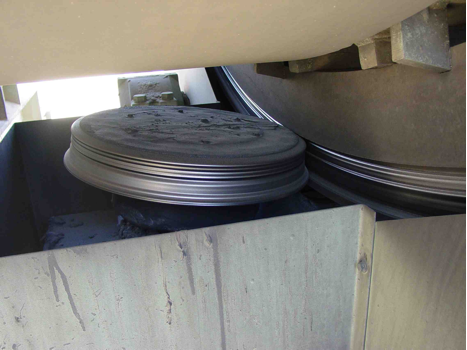
Improper float is causing the thrust roller to ride hard against the tire (riding ring)
Drive Component Damage
Drive components can also be affected by a poorly installed base; if a drive base becomes “bent,” the shafts between the motor and reducer and gear and pinion can become damaged. Additional damage may occur in couplings and other drive components.
Catastrophic Failure
In severe cases, poorly installed bases can cause cracks in the equipment, which, if not quickly addressed, can lead to catastrophic failure of the unit.
Ensuring Proper Rotary Drum Base Installation
As can be seen, ensuring proper base installation is the first step in setting a solid foundation for the life of a rotary drum.
For this reason, FEECO recommends all new rotary drums enlist the assistance of the OEM or a qualified rotary drum service provider to assist in the drum base installation.
Have a Rotary Drum Service Provider On-Site
Installation support services may differ depending on the provider. FEECO Customer Service Engineers can serve as a single point of contact for mechanical and structural procedures in order to streamline scheduling and any issues that might arise. They can also help to minimize re-work and ensure critical hold points are not overlooked by sequencing order of installation, which could otherwise result in voided warranties.
Customer Service Engineers can also perform laser alignments on site to ensure the bases and all components are aligned for optimal mechanical stability.
Properly Preparing the Base
In addition to having a service provider on site for installation, it is essential to ensure adequate preparation of the base prior to installation day.
When grout will be used to secure the bases, be sure to select the correct grout. Grout serves as the support foundation under the trunnion and drive bases. Once bases have been set and aligned, grout is poured, flowing around and under the bases to fill in any voids and provide complete support to the weldment.
Give grout sufficient time to cure (typically around 24 hours of cure time is recommended, but this can vary between manufacturers) prior to setting the bases to ensure the bases do not move when the drum is set on top of them. Grout that has not had proper time to cure may allow the bases to shift slightly when the drum is placed, throwing off the alignment.
Once grout has cured, anchor bolts should be tightened to ensure a stable hold.
Addressing a Poorly Installed Base
In some cases, plant managers may find themselves dealing with an improperly installed base in an existing plant.
In the case of a newer rotary drum, it may be worth lifting the drum off of its base and reinstalling the base components. The costs involved to do this may or may not be an option depending on a range of factors, including drum accessibility, condition of the drum, production schedules, and more.
When reinstalling base components is not an option, it is possible to address misalignment by shimming and skewing the trunnion bearings instead of the frame on which they are mounted. This is not a preferred option, because it is best to have the bearing sitting directly on the frame, but in some cases it may be the best approach.
A laser alignment can also help to lessen the effects of a poorly installed base and promote mechanical stability.
Signs of Poor Drum Base Installation
Signs that existing base installation may be inadequate include the need for regular rotary drum realignment, excessive skewing requirements, cracks in the steel or foundation, and excessive noise and/or vibration. Unfortunately, whether a drum base was poorly installed, or another issue is causing mechanical issues, is not always evident.
For this reason, FEECO recommends that plant managers experiencing issues with an existing unit bring in an expert to conduct an inspection. This thorough assessment is used to evaluate the mechanical condition of the drum, revealing any underlying problems, furnishing benchmarking data, and providing guidance to issue resolution.
After inspecting the drum, FEECO Customer Service Engineers can then with plant managers and maintenance personnel to determine the best course of action.
Conclusion
Proper rotary drum base installation is the first step in an effective preventive maintenance program, helping to reduce maintenance costs and downtime, while promoting a long rotary drum service life.
FEECO is the industry leader in manufacturing and servicing rotary drums. From installation support to routine maintenance, retrofits, and even spare parts, FEECO has all of your rotary drum needs covered. For more information on our rotary drum services, contact us today!


